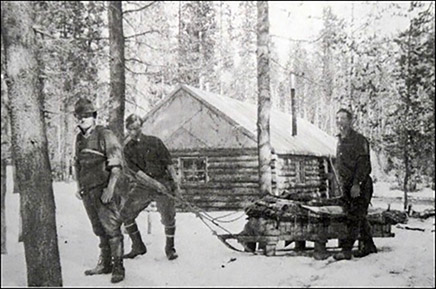LAVA LAKE, DESCHUTES COUNTY; 1920s:
Missing trapper’s mom suspected foul play
Audio version: Download MP3 or use controls below:
|

Well, that could have been explained away; conceivably, after the three men left for whatever reason, a traveler might have come by and, finding the cabin vacant, lived in it for a few days. But where the men might have gone was another tricky question. Their bedrolls, most of their heavy winter clothing, and all but two of their guns — a Colt .22 revolver and Wilson’s war-souvenir Luger automatic — were still in the cabin. Where would the three of them have gone without heavy coats or firearms? There was a meal out for the farm foxes, but the foxes were gone. Had they escaped, or had someone stolen them? The visitors made the rounds of the boys’ trapline. They found the corpses of several martens and wild foxes in the traps — the animals had sprung the traps and then, stuck in them, died of thirst. Yet there were no pelts in the cabin. Had they not been running their trapline, or had someone stolen all their pelts? Answers were not slow in coming to light. On April 20, the visitors found a big spot of blood in the snow; it was sandwiched between a lower and upper layer of clean white stuff, as if it had been spilled and frozen several weeks or months earlier. There were also tracks, visible despite an inch or two of snow having fallen since they were made, of a heavily-laden sled having been pulled away across the snow in the direction of Big Lava Lake. Following those tracks, the investigators found that they went out onto the lake, and ended at a spot where someone had chopped a hole in the ice … a hole just big enough to slip a body through. And caught in a crack in the ice near the edge was a medium-length strand of sandy-brown human hair. Then someone found the missing foxes. They’d been killed, skinned, and hidden in the bushes. There was no longer any room for doubt: The three trappers had clearly been murdered, and the motive was either robbery — or revenge. A few days later, Portland furrier Carl Schumacher, having seen the coverage of the mystery in the Portland Morning Oregonian, contacted the police to report that a man had brought four fox pelts in to his shop on Jan. 22 — seven days after the three men had last been seen alive. Schumacher remembered the situation well, because the pelts had been mishandled; the trapper, who stayed and chatted with him for half an hour or so about various trapper-related things and seemed to be an old hand at the game, apparently didn’t know how to properly stretch and cure a valuable pelt, and although the pelts weren’t ruined, they had lost considerable value as a result. By the time Schumacher contacted the cops, they were already looking into Charles Hyde Kimzey as a suspect. They showed Schumacher a photograph. Schumacher said he couldn’t give a positive I.D., but the photo definitely looked like it could be the same man. But Kimzey was still on the lam. There was still no sign of him when, a month or two later, the ice in the lake melted, and all three bodies were found floating in it. Police lassoed them and towed them to shore. The evidence they found on the bodies put to rest any lingering doubts about whether or not they’d been murdered. We’ll talk about that, and about the efforts to figure out who did it, in Part Two.
|
Background image is a hand-tinted linen postcard view of Three Sisters from Scott Lake, circa 1920.
Scroll sideways to move the article aside for a better view.
Looking for more?
On our Sortable Master Directory you can search by keywords, locations, or historical timeframes. Hover your mouse over the headlines to read the first few paragraphs (or a summary of the story) in a pop-up box.
... or ...

©2008-20121 by Finn J.D. John. Copyright assertion does not apply to assets that are in the public domain or are used by permission.

236.jpg)